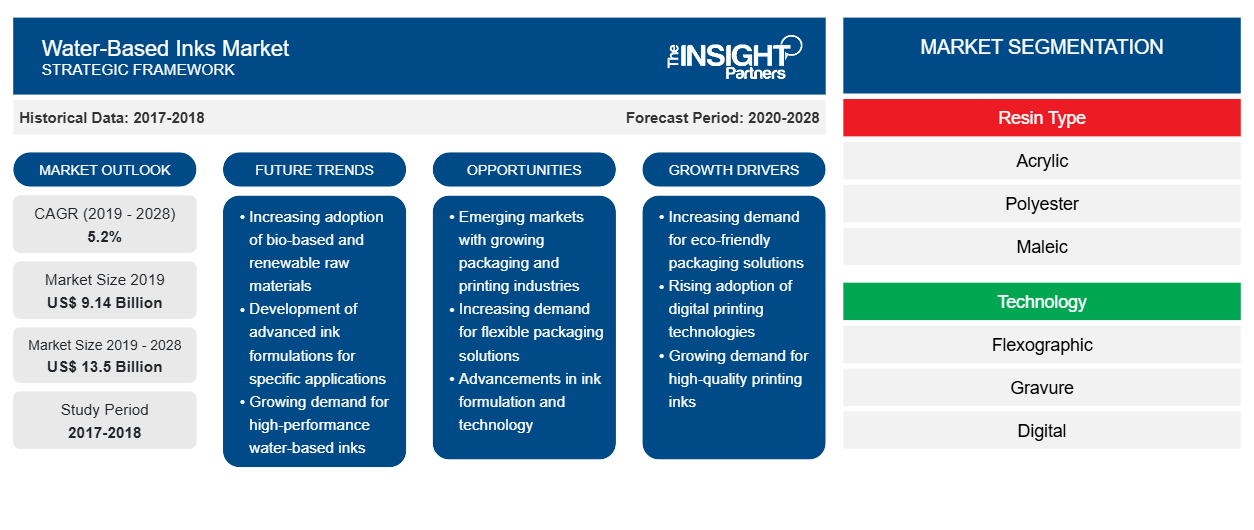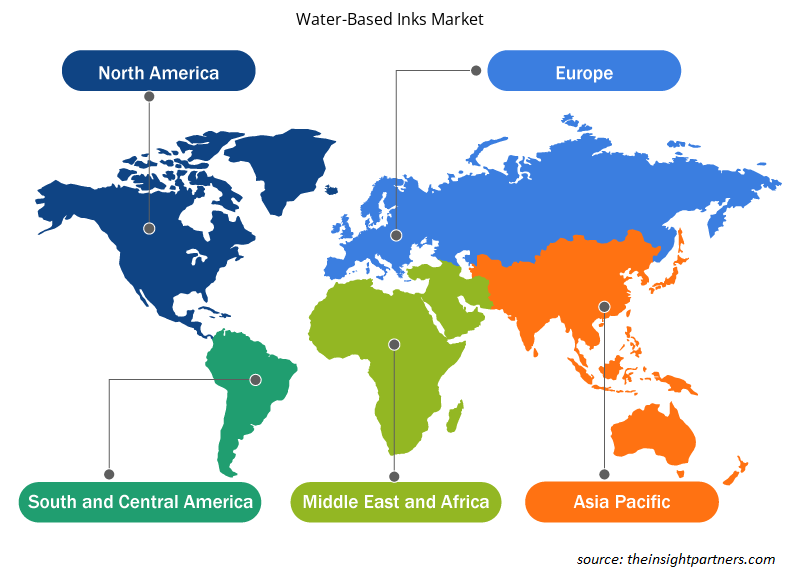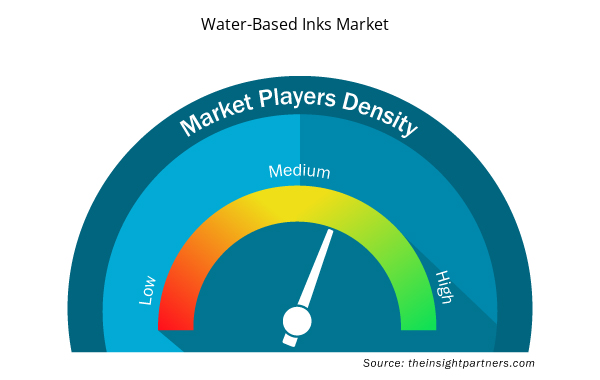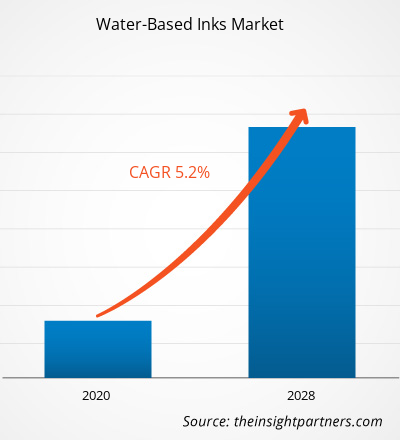The water-based inks market was valued at US$ 9,141.20 million in 2019 and is projected to reach US$ 13,496.39 million by 2028; it is expected to grow at a CAGR of 5.2% from 2020 to 2028.
Water-based ink includes pigment or dyes in a colloidal suspension with water as the solvent. While water is the primary solvent used in the production of water-based inks, the inks can contain other co-solvents to reduce the time and heat required to cure the ink film on cloth. Water-based inks have a higher viscosity stability on press because water evaporates slowly. The demand for water-based inks has been increasing due to a rise in environmental and safety concerns, growth in flexible packaging, and increased utilization in screen printing.
In 2019, APAC contributed to the largest share in the global water-based inks market. The growth of the water-based inks market in this region is primarily attributed to the increasing demand from developing countries such as China and India. These countries are experiencing tremendous growth in printing & packaging industry. The continuous growth in food & beverages, pharma, and personal care industries demands for high-quality packaging & labelling products. Water-based printing inks is an excellent ink system for paper and cardboard printing. They have better gloss and color and good surface appearance compared to other printing inks on an absorbent substrate such as paper and cardboard, and when it comes to slower printing application. Water-based ink emits much less Volatile Organic Compounds (VOCs), thus, the cost related to pollution emission is much less when compared to solvent-based ink. All these advantages have increased the adoption of water-based inks in APAC. Apart from this, water-based inks penetrate deeper within the fabric, and they are able to produce longer lasting prints with impeccable detail, with much more defined, sharper edges. This includes half-tones and more, making them the perfect choice for printing intricate, detailed designs. The growing demand for water-based inks from textile printing in APAC is expected to drive the demand for water-based inks during the forecast period.
The ongoing COVID-19 pandemic has drastically altered the growth status of the water-based inks industry. The outbreak has distorted operational efficiency and disrupted the value chains due to the sudden shutdown of national and international boundaries, creating revenue loss and damage. The disturbed value chain has had a negative impact on raw material supply. However, as the economies are planning to revive their operations, the demand for water-based inks is expected to rise globally in the coming months. The focus over just-in-time production is another factor hindering the water-based inks market growth. With the projected rise in the importance of sustainability and application diversification in post-pandemic times, the demand for water-based inks is expected to take huge leaps. Several associations such as The Association for Packaging and Processing (PMMI) are involved in keeping a close check on the effects of the pandemic upon the printing and packaging industry along with providing necessary avenues thereof to the concerned parties. Therefore, effective measures taken by such associations to support packaging industry, backed by positive government initiatives, are expected to generate the demand for water-based inks in the coming years. Further, significant investments by prominent companies in the development of advanced products is yet another factor supporting the market growth.
Customize This Report To Suit Your Requirement
You will get customization on any report - free of charge - including parts of this report, or country-level analysis, Excel Data pack, as well as avail great offers and discounts for start-ups & universities
Water-Based Inks Market: Strategic Insights

- Get Top Key Market Trends of this report.This FREE sample will include data analysis, ranging from market trends to estimates and forecasts.
Customize This Report To Suit Your Requirement
You will get customization on any report - free of charge - including parts of this report, or country-level analysis, Excel Data pack, as well as avail great offers and discounts for start-ups & universities
Water-Based Inks Market: Strategic Insights

- Get Top Key Market Trends of this report.This FREE sample will include data analysis, ranging from market trends to estimates and forecasts.
Market Insights
High Demand in Flexible Packaging
Flexible packaging is a type of packaging or any part of the packaging made from a non-rigid structure, and it can be easily molded into different shapes. This type of packaging allows for better transportation of the packaged goods, along with enabling customizable designs and better life span. As per the Flexible Packaging Association, the flexible packaging is considered to be the second largest contributor to the growth of packaging segment in the US, as it garnered ~19% of the packaging market in the country, which was worth US$ 170 billion in US in 2018. The inks used in flexible packaging help enhance the overall graphic representation and maintain the quality of imprinted images during phases such as manufacturing, packaging, and transportation, as well as at the time of the final use of the product. Earlier, solvent-based inks were extensively in use instead of water-based inks, due to drawbacks associated with the latter, such as lower printing speeds, slower water evaporation, improper wetting mechanism, and imperfect printability on critical substrates. However, the demand for water-based inks has grown incessantly owing to increasing focus on sustainability. The advancements in printing techniques such as deployment of improved resins, better ink formulation, and high-performance printing equipment have helped printing manufacturers to overcome the drawbacks of water-based inks. These developments have enabled the water-based inks to meet the performance standards associated with flexible packaging materials. Marabu is involved in production and supply of water-based inkjet inks used in flexible packaging of the food & beverages industry products as well as the consumer goods industry products, such as cardboard boxes, toys, and digitally printed wallpapers.
Resin Type Insights
Based on resin type, the water-based inks market is segmented into acrylic, polyester, maleic, and others. The acrylic segment led the market with the largest share in 2019. Water-based acrylic paint is composed of pigment particles that are dispersed in an acrylic polymer emulsion. The pigments are granular solids that provide paint its color. They are milled into tiny particles and remain suspended in the paint. These pigments can either be organic, inorganic, natural, or synthetic. The binder is a substance that keeps the pigment in place after the ink dries..
Key market players operating in the water-based inks market include DIC Corporation; Flint Group; Hubergroup; Sakata Inx Corporation; Siegwerk Druckfarben AG & Co. KGaA; T&K TOKA Co. Ltd.; Toyo Ink SC Holdings Co., Ltd.; Fujifilm Holdings Corporation; American Inks & Technology; and Wikoff Color Corporation. Major market players are adopting strategies such as mergers and acquisitions and product launches to expand their geographical presence and consumer base globally.
Report Spotlights
- Progressive industry trends in the global water-based inks market to help players develop effective long-term strategies
- Business growth strategies adopted by developed and developing markets
- Quantitative analysis of the global water-based inks market from 2019 to 2028
- Estimation of the demand for water-based inks across various industries
- PEST analysis to illustrate the efficacy of buyers and suppliers operating in the industry to predict market growth
- Recent developments to understand the competitive market scenario and the demand for water-based inks
- Market trends and outlook coupled with factors driving and restraining the growth of the water-based inks market
- Decision-making process by understanding strategies that underpin commercial interest with regard to global water-based inks market growth
- Water-based ink market size at various nodes of market
- Detailed overview and segmentation of the global water-based inks market, as well as its dynamics in the industry
- Water-based ink market size in various regions with promising growth opportunities
Water-Based Inks Market Regional Insights
The regional trends and factors influencing the Water-Based Inks Market throughout the forecast period have been thoroughly explained by the analysts at Insight Partners. This section also discusses Water-Based Inks Market segments and geography across North America, Europe, Asia Pacific, Middle East and Africa, and South and Central America.

- Get the Regional Specific Data for Water-Based Inks Market
Water-Based Inks Market Report Scope
| Report Attribute | Details |
|---|---|
| Market size in 2019 | US$ 9.14 Billion |
| Market Size by 2028 | US$ 13.5 Billion |
| Global CAGR (2019 - 2028) | 5.2% |
| Historical Data | 2017-2018 |
| Forecast period | 2020-2028 |
| Segments Covered |
By Resin Type
|
| Regions and Countries Covered | North America
|
| Market leaders and key company profiles |
Water-Based Inks Market Players Density: Understanding Its Impact on Business Dynamics
The Water-Based Inks Market market is growing rapidly, driven by increasing end-user demand due to factors such as evolving consumer preferences, technological advancements, and greater awareness of the product's benefits. As demand rises, businesses are expanding their offerings, innovating to meet consumer needs, and capitalizing on emerging trends, which further fuels market growth.
Market players density refers to the distribution of firms or companies operating within a particular market or industry. It indicates how many competitors (market players) are present in a given market space relative to its size or total market value.
Major Companies operating in the Water-Based Inks Market are:
- DIC Corporation
- Flint Group
- Hubergroup
- Sakata Inx Corporation
- Siegwerk Druckfarben AG & Co. KGaA
Disclaimer: The companies listed above are not ranked in any particular order.

- Get the Water-Based Inks Market top key players overview
Water-Based Inks Market, by Resin Type
- Acrylic
- Polyester
- Maleic
- Others
Water-Based Inks Market, by Technology
- Flexographic
- Gravure
- Digital
- Others
Water-Based Inks Market, by Application
- Packaging
- Publication
- Tags and Labels
- Others
Company Profiles
- DIC Corporation
- Flint Group
- Hubergroup
- Sakata Inx Corporation
- Siegwerk Druckfarben AG & Co. KGaA
- T&K TOKA Co. Ltd.
- Toyo Ink SC Holdings Co., Ltd.
- Fujifilm Holdings Corporation
- American Inks & Technology
- Wikoff Color Corporation
- Historical Analysis (2 Years), Base Year, Forecast (7 Years) with CAGR
- PEST and SWOT Analysis
- Market Size Value / Volume - Global, Regional, Country
- Industry and Competitive Landscape
- Excel Dataset


- Dairy Flavors Market
- Workwear Market
- Bathroom Vanities Market
- Bioremediation Technology and Services Market
- Lyophilization Services for Biopharmaceuticals Market
- Dried Blueberry Market
- Virtual Pipeline Systems Market
- Equipment Rental Software Market
- Third Party Logistics Market
- Passport Reader Market

Report Coverage
Revenue forecast, Company Analysis, Industry landscape, Growth factors, and Trends

Segment Covered
Resin Type , Technology , and Application

Regional Scope
North America, Europe, Asia Pacific, Middle East & Africa, South & Central America

Country Scope
Argentina, Australia, Brazil, Canada, China, France, Germany, India, Italy, Japan, Mexico, Russian Federation, Saudi Arabia, South Africa, South Korea, United Arab Emirates, United Kingdom, United States
Frequently Asked Questions
Based on application, the packaging segment held the largest share in the global water-based inks market in 2019. The packaging segment comprises flexible packages, tags, corrugated containers, labels, metal cans, and folding cartons. Increasing demand for flexible packaging in the food and beverages sector due to its esthetic appeal and less weight, is expected to fuel the demand for packaging in the next few years. Water-based inks have improved flow behavior, gloss, color, good surface appearance. It improves the efficiency of packaging production, reduces wasted ink, and improves operating rates for printing equipment. Apart from this, food & beverage, and personal care companies demand for packages that adds value and marketability to their products. Thus, the demand for high-quality tags, corrugated containers, labels is increasing which further supports the growth of water-based inks market. With an increasing consumer focus on sustainability, traditional rigid packaging solutions are being replaced by innovative, eco-friendly packaging solutions. Water-based inks do not contain Volatile Organic Compounds (VOC), thus making them popular choice for packaging.
The major players operating in the global water-based inks market are DIC Corporation, Flint Group, Hubergroup, Sakata Inx Corporation, Siegwerk Druckfarben AG & Co. KGaA, T&K TOKA Co. Ltd., Toyo Ink SC Holdings Co., Ltd., Fujifilm Holdings Corporation, American Inks & Technology and Wikoff Color Corporation among many others.
In 2019, APAC contributed to the largest share in the global water-based inks market. The growth of the water-based inks market in this region is primarily attributed to the increasing demand from developing countries such as China and India. These countries are experiencing tremendous growth in printing & packaging industry. The continuous growth in food & beverage, pharma and personal care industry demands for high-quality packaging & labelling products. Water-based printing inks is an excellent ink system for paper and cardboard printing. They have better gloss, color, good surface appearance as compared to other printing inks when it comes to slower printing application and on an absorbent substrate such as paper and cardboard. Water-based ink emits much less VOCs thus, the cost related to pollution emission is much less when compared to solvent-based ink. All these advantages have increased the adoption of water-based inks in APAC region.
Trends and growth analysis reports related to Chemicals and Materials : READ MORE..
The List of Companies - Water-based Inks Market
- DIC Corporation
- Flint Group
- Hubergroup
- Sakata Inx Corporation
- Siegwerk Druckfarben AG & Co. KGaA
- T&K TOKA Co. Ltd.
- Toyo Ink SC Holdings Co., Ltd.
- Fujifilm Holdings Corporation
- American Inks & Technology
- Wikoff Color Corporation

 Get Free Sample For
Get Free Sample For